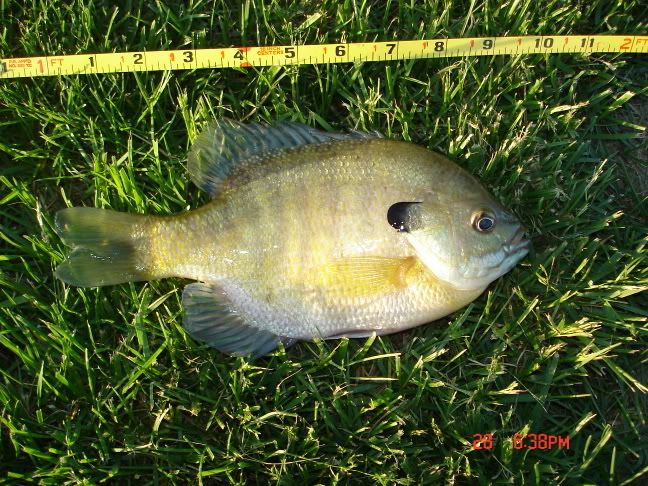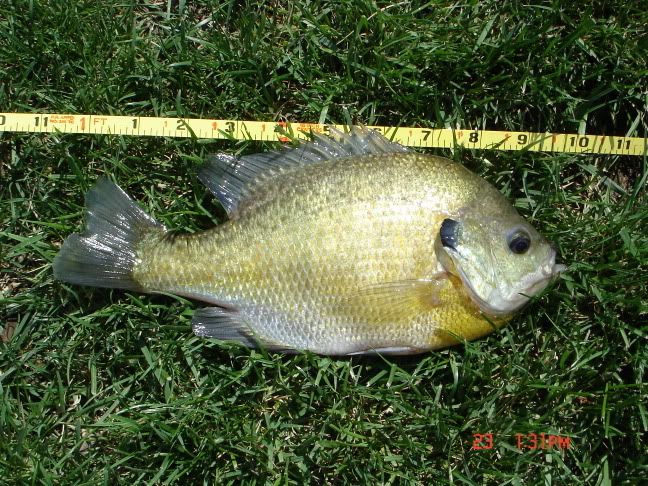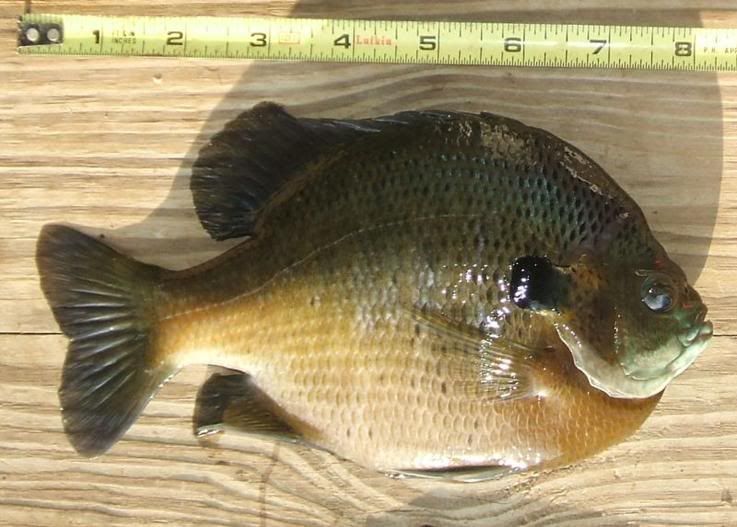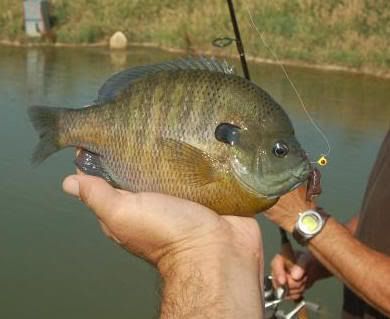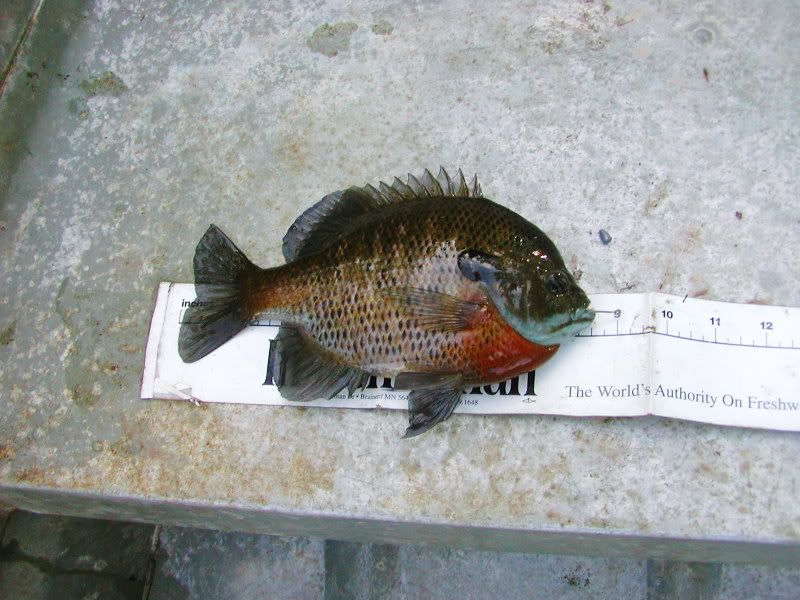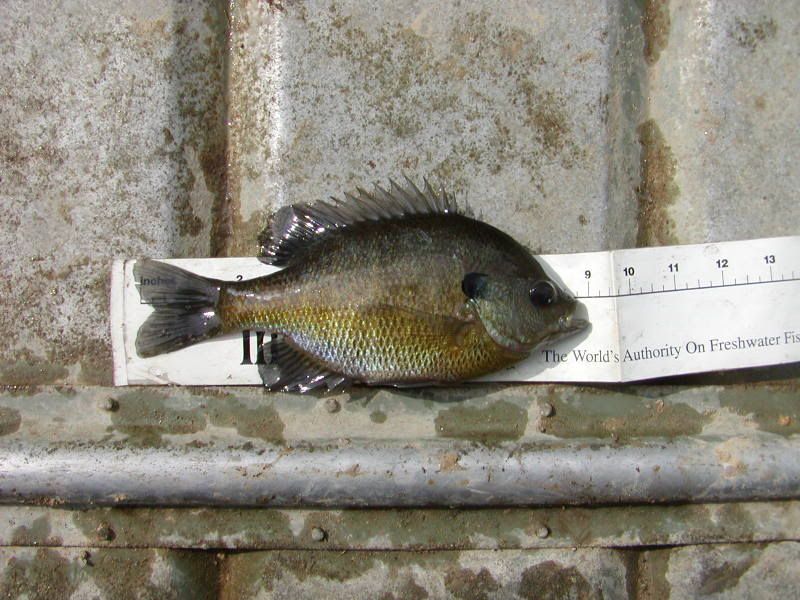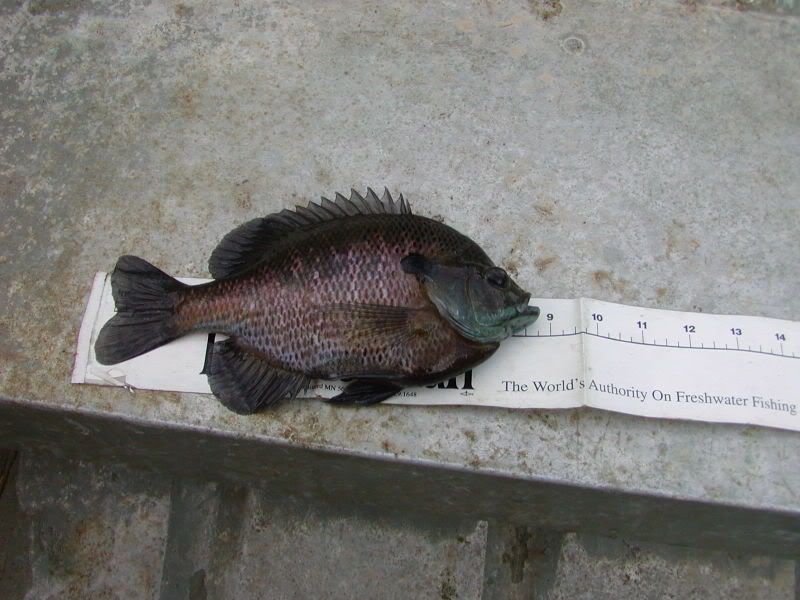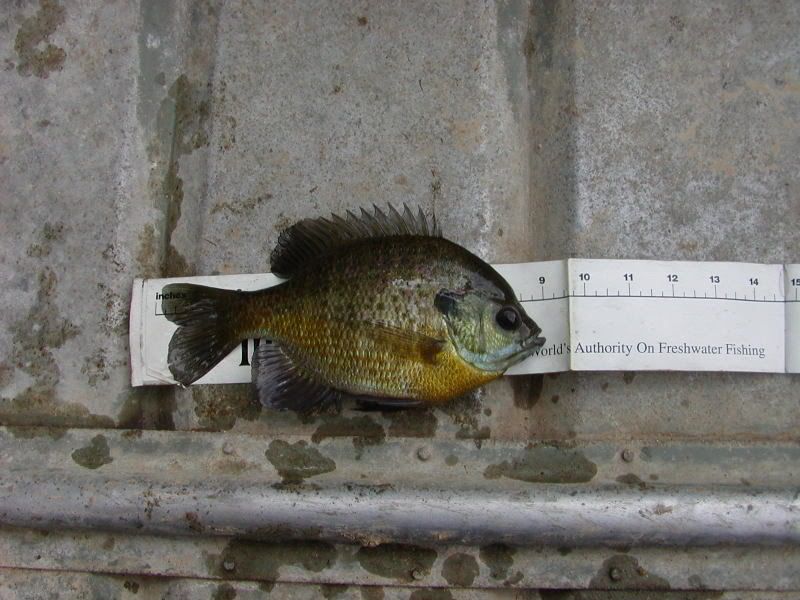Without seeming negative...I see what you mean.
I've got plenty of fish that look just like that--even in the production ponds with CSBG, but I'm looking to up the numbers of the "saucer shaped" fish that you're referring to.
Most ponds that I fish, or check on, have fish with the bigger head/body ratio like you've got in your pics. These are healthy fish, that can get really nice sized, but I suspect that they are older fish, with a little less top-end potential.
I've always thought that fish that looked like yours are healthy, fun, great-tasting etc., but if I have a feeder set up I will see the taller, better Wr fish near the feeder. I think you can start selecting fish for eating/harvest by differentiating which fish have the better Wr's and harvest the fish with lower values.
My gut instinct is to say that you don't have any type of problem, and just need to start being a little more intense in your selection process. It's all about stacking the odds in your favor, and that's one way to do it.
Ryan,
How old are your BG? They may not be old enough to have have all the male characteristics yet. I suppose it takes longer in cooler climates.
EDIT: 10"??? Never mind...
I dont know. It seems that the groceries have been lacking for a little while RGT these fish. At 10 inches, shouldnt they have weighed more at one time? Any weights,Ryan?
If Bruce says he has some that look just like that, it would be a great relief to me. As they say, you have to eat some of them; they look like prime candidates.
Ryan -- one other possibility. There's been at least some thought that there are two body forms for bluegills. One is the saucer shape, and the other is more streamlined. If a bluegill lives in submergent vegetation, the saucer shape would be better for avoiding predators (fast turns) and feeding. If a bluegill lives in an open-water environment, then the longer body shape might be better for predator avoidance (faster).
Actually, that speculation is the easy part. Now, the hard part: is it genetics, or is it an adaptation to the environment (meaning that all bluegills have the capability to go "either way" depending on the habitat in which they live)? I have not seen an answer to that one.
This should start some discussion, eh???

Ryan -- one other possibility. There's been at least some thought that there are two body forms for bluegills. One is the saucer shape, and the other is more streamlined. If a bluegill lives in submergent vegetation, the saucer shape would be better for avoiding predators (fast turns) and feeding. If a bluegill lives in an open-water environment, then the longer body shape might be better for predator avoidance (faster).
Actually, that speculation is the easy part. Now, the hard part: is it genetics, or is it an adaptation to the environment (meaning that all bluegills have the capability to go "either way" depending on the habitat in which they live)? I have not seen an answer to that one.
This should start some discussion, eh???

Whoa! This gives me something really cool to put in
http://www.bigbluegill.com !
Is there a something I can draw off of to put together a little article? I'm sure I could take the bluegills above, and have Bill Coddy put them in a combination slide with a couple of Bassandgrass or Theo's crazy saucers.
Maybe Dr. Dave can even write a paragraph or two if I can talk Cody into helping me with the slide. (hint, hint, hint)
Dave that is news to me. I have not seen that written. I need to check. Where did you get that bit of info. It is so simple and makes so much sense that it plain never registered. Uggh.
Why do my best BG look like saucers, when my pond has NO weeds?
IS it genetics?
Another mystery to figure out.

Theo, I think your current dominant body morphology would be more a function of what happened for the last several generations in whatever facility or location that they came from. You haven't had enough generations to begin to match up with your pond's particular situation.
Anyway, you're the dominant predator right?

Ewest -- I heard it from some of the Illinois Natural History Survey biologists. Same crew that really increased the recognition of the bluegill cuckoldry. Don't know if anything is in print or not. Will find out next week after we get back from the AFS meeting in Ottawa.
Bruce -- will see if I can get some "hard" documentation and not just this speculation.
Theo -- I never said it was true.

I have seen some instances where it seems to make sense -- like when you still produce 10.5 inch bluegills, but they are longer (like in one of our nearby lakes that is large, shallow, and no plants).
Theo, I think your current dominant body morphology would be more a function of what happened for the last several generations in whatever facility or location that they came from. You haven't had enough generations to begin to match up with your pond's particular situation.
Anyway, you're the dominant predator right?

By volume or mass, yes, whether you're looking at BG removed or predator size (215lbs to 10-ish for the big CC).
Where do you draw the line between adaptation and genetic change ?
Long term adaptation is the genesis of original genetic change.
The catalysis can be man , weather , geologic change etc.
Where do you draw the line between adaptation and genetic change ?
Excellent question....
The pictures I posted were from June of 2006 and probably recently spawned out. The fish were likely 4 years old assuming the fish I stocked were 1 year old. At the time the photos were taken, I was feeding Purina Gamefish Chow once a day by hand. I switched to Aquamax 400 a few months ago and my fish seem to be a little heavier. There are no weeds in the pond and limited manmade structure (pallets, sputniks,brick pile, and field tiles). In my case, these are a result of the stocker genetics since the pond was built in October of 2002. Bluegill I've caught from lakes near my house are even more streamlined than those in my pond and vary from weed choked and shallow to nearly structure free.
Dave Willis, your natural selection theory is interesting. I was thinking along the same lines but just the opposite. Wouldn't a more saucer shaped bluegill be harder to swallow than a streamlined one?
Based on the pictures, would multiple per day feedings of my existing fish grow them to dinner plate proportions or should I search further to get BG with the genes I am looking for? The two fish suppliers within reasonable distance of me have fish like the ones I posted.
Ryan -- you sure make a good point. I think the "thought" on this one is that the saucer (compressed) shape is best for quick turns in vegetation, and avoid predation by quick movement and hiding. In open water, the streamlined body shape would be fast, and the streamlined ones would outrun the saucers, leaving the saucers behind to be eaten first??
I sort of took us down a tangent here -- one of those stray thoughts that pops into the brain.

We do NOT know how or if genetics are involved, or even if this is all true. Maybe all bluegills have the option to go to either form of body morphology? Thus, I think that I sure would try the feeding program first??
Guys?? Other thoughts for Ryan?
I think you're right Dave. I don't think a bass would care what shape it was as long as it could catch it.
Maybe all bluegills have the option to go to either form of body morphology?
That would be my guess.

IMHO I think the different body shapes are indicative of both the amount of food available present and the amount of competition for those food resources over the course of a fishes lifestime. BG growing up with little competition and lots of food will be more saucer shaped. BG with more competition and fewer food resources will be more streamlined. There are also similar body shape patterns with LMB in terms of shoulder hieght and girth. My guess is that if you aged both the streamlined and saucer shaped BG you would find the saucer shaped BG to be significantly younger than the streamlined ones of the same length. That's my opinion and I'm sticking to it until more research has been done.

This should be a good discussion.

To much competition for food and BG stunt. I would guess that most of the observations that Dave based his comment on were from natural lakes not ponds with supp feeding. BG food size and variety (absent pellet feeding ) is so diverse that while some (small ones) are stunting in one age class others of a different age class (big ones) are getting very fat (some streamlined and some saucer shaped). George has a bunch of saucers and no weeds IIRC. I have some weeds and a lot of open water and have some of both body shapes. What do you guys see in your ponds (weeds or not and results - saucers or streamline or both) ?

Shorty I will start the research.
This should be a good discussion.

To much competition for food and BG stunt. I would guess that most of the observations that Dave based his comment on were from natural lakes not ponds with supp feeding. BG food size and variety (absent pellet feeding ) is so diverse that while some (small ones) are stunting in one age class others of a different age class (big ones) are getting very fat (some streamlined and some saucer shaped).
George has a bunch of saucers and no weeds IIRC. I have some weeds and a lot of open water and have some of both body shapes. What do you guys see in your ponds (weeds or not and results - saucers or streamline or both) ?

Absolutely NO weeds - very little structure - CNBG shaped like dinner plates...

What do you guys see in your ponds (weeds or not and results - saucers or streamline or both) ?

The fatter my BG are, the more they look like saucers. Skinnier BG (which tend to be shorter also in my pond) are more streamlined.
I have always thought it was a function of how much they were getting to eat - fat, fast growers are saucers.
P.S. To reiterate, pond is almost weedless.
P.S. To reiterate, pond is almost weedless.
Braggart.
Hi guys. I'm in Ottawa at the American Fisheries Society meeting. There is a poster here on pumpkinseeds and their body morphs. That work talks about four body morphs for pumpkinseeds. One set is flowing water (streamlined) vs. standing water (compressed/saucer). The other split they had was littoral (shallow,nearshore/saucer) vs. open water (streamlined).
Ewest, they cited two papers if you want to try and find them.
Gillespie and Fox 2003, pumpkinseeds morphs, J Fish Biology 62:1099-1115
Bhajat et al. 2006, J Fish Biology 69(C):79-94
Bruce -- after we track down these papers, we can see if they also cite any bluegills papers on body morphs.
Theo, I'm still not sure how they separate condition/feeding from supposed morph.
Theo, I'm still not sure how they separate condition/feeding from supposed morph.
Could the different morphs be aged? I suspect that an 8" sacuer shaped BG is significantly younger than an 8" streamlined BG by at least one year.

Could not get those articles yet but found these.
Tramactions of the American Fisheries Society 109:108-115, 1980
¸ Copyright by the American Fisheries Society 1980
Genetic and Morphological Variation of Bluegill
Populations in Florida Lakes
JAMES D. FELLEY
Department of Zoology, University of Oklahoma
Norman, Oklahoma 73019
JOHN C. AVISE
Department of Zoology, University of Georgia
Athens, Georgia 30602
Abstract
The structure of bluegill (Lepomis macrochirus) populations in natural Florida lakes was assessed
from clcctromorphic and morphologicharacters. Elcctrophorctically assaycd allclc frequencies
arc homogeneous within lakes and heterogeneous among lakes. Populations in two adjacent
lakes connected by a short river arc nearly identical. Several considerations indicate that cvcn
young-of-the-year bluegills arc well mixed within subpopulations of these lakes, and that indi-
vidual dispersal is important in maintaining intcrsubpopulation homogcncity in allclc frequency.
This pattern of genetic differentiation contrasts with the pattern of hctcrogcncity observed in
mcristic counts for several morphological traits. At the microgeographic level, genetic homo-
gcncity probably reflects a long-term history of bluegill movements within a lake, while within-
lake morphological hcterogcncity reflects the varied conditions during individual development
to which incompletely isolated subpopulations are exposed.
The genetic homogeneity observed within
lakes is not reflected in the morphological char-
acteristics (Fig. 2). Hagen (1973) found high
heritabilities for meristics traits but noted that
heritability can only be defined for given envi-
ronmental conditions. Meristic traits are influ-
enced during embryonic development by such
environmental variables as temperature, CO2
concentration, salinity, and pH (T•ning 1952;
Barlow 1961; Fowler 1970). The variation in
locality means for these meristic traits may thus
be evidence of the environmental conditions,
varying temporally and microgeographically, to
which the developing fish were subjected. Thus
we can envision the possibility of a lake con-
sisting of/a patchwork of environmental con-
ditions influencing developmentally plastic
traits. Between-locality heterogeneity in such
morphological characters would then be regen-
erated in each generation, while the between-
locality homogeneity in genetic composition re-
flects effects of a long-term history of bluegill
movement within a lake.
On a broader perspective, all bluegills in the
Florida lakes are similar to one another, both
morphologically and genetically. Their meristic
counts and genotype frequencies are character-
istic of the Florida bluegill subspecies, and are
very distinct from bluegills from Georgia and
South Carolina to Texas (Avise and Smith
1974; Felley, in press). At the macrogeographic
level, there is a clear correspondence between
morphology and genetics. At the microgeo-
graphic level, genetic homogeneity may reflect
the long-term history of bluegill movement
within a lake, while morphological heteroge-
neity reflects the varied developmental condi-
tions to which individuals in incompletely iso-
lated subpopulations are exposed.
North American Journal of Fisheries Management 17:543-556, 1997
© Copyright by the American Fisheries Society 1997
Geographic Patterns in Genetic and Life History Variation in
Pumpkinseed Populations from Four East-Central
Ontario Watersheds
MICHAEL G. Fox
Environmental and Resource Studies Program and Department of Biology
Trent University, Peterborough, Ontario K9J 7B8, Canada
JULIE E. CLAUSSEN AND DAVID P. PHILIPP
Center for Aquatic Ecology, Illinois Natural History Survey
607 East Peabody Drive, Champaign, Illinois 61820, USA
Abstract.—We examined the geographic distribution of biochemical genetic and life history
characteristics of 16 populations of pumpkinseed Lepomis gibbosus within four east-central Ontario
watersheds to determine (1) if populations within watersheds were more alike for either of these
traits than populations among watersheds, (2) if the distribution of genetic and life history characteristics
among watersheds coincided with each other, and (3) if the distribution of genetic and
life history characteristics among watersheds showed some geographic pattern. Pumpkinseeds
collected early in the reproductive season in the years 1990-1993 were assessed for reproductive
maturity, gonadosomattc index (females only), and juvenile growth. Allele frequencies at six
polymorphic loci were determined by protein electrophoresis. Cluster analysis based upon genetic
distance coefficients showed three distinct groups, one containing populations from the Rideau
River watershed, a second containing populations from the Crowe River watershed, and a third
containing a mixture of populations from the Cataraqui River and Otonabee River watersheds.
This cluster pattern does not coincide with a geographic distance matrix among river systems
based upon current watersheds, but is consistent with suggested post-Pleistocene recolonization
routes from both the Mississippi and Atlantic refugia. Mean age and length at maturity, however,
showed an east-west pattern of variation, with the populations in the two central Ontario watersheds
maturing earlier and at a smaller size than the populations in the two eastern Ontario watersheds.
The cluster pattern of life history traits also did not coincide with a geographic distance matrix
based upon current watersheds, nor did it coincide with the cluster pattern based upon genetic
distance coefficients. The differences in genetic and life history patterns may reflect original
founder effects during initial recolonization events, the effects of drift subsequent to that time,
life history responses to east-west differences in natural or human-induced environmental factors,
or some combination of these factors. These observed patterns in the distribution of genetic
variation (i.e., the clustering of populations within watersheds) support the concept of managing
native fisheries by the stock concept.
Fish also exhibit interpopulational variation in
life history traits, some of which can be attributed
to genetic factors (McPhail 1977; Fields, et al.
1987; Gharrett et al. 1988; Snyder and Dingle
1988; Beacham el al. 1989; Philipp and Whitt
1991; Toline and Baker 1994; see also Stearns and
Koella 1986). A high degree of variation in reproductive
life history traits has been shown to
occur even among fish populations within the same
geographic region. Although some of this variation
is clearly related to environmental variability (e,g,,
Constantz 1979; Baltz and Moyle 1982; Fox and
Keast 1991), reproductive life history variation
within a geographic region also occurs among fish
populations for which major environmental differences
are not evident (Schmeidler and Brown
1990; Hutchings 1993; Fox 1994).
More
FELLEY, J. In press. Analysis of morphology and
asymmetry in bluegill sunfish (Lepomis macrochi-
rus) in the southeastern United States. Copeia.
NEY, J.J., AND L. L. SMITH, JR. 1976. Serum protein
variability in geographically defined bluegill (Le-
pomis macrochirus) populations. Transactions of
the American Fisheries Society 105:281-290.
From
Evolutionary Ecology Research, 1999, 1: 111–128
© 1999 Gary G. Mittelbach
Variation in feeding morphology between pumpkinseed
populations: Phenotypic plasticity or evolution?
Gary G. Mittelbach,1* Craig W. Osenberg2 and Peter C. Wainwright3‡
These results show that the natural variation in
pharyngeal morphology between these populations of pumpkinseeds is primarily the result of a
plastic response to the environment, rather than a response to selection driven by the environmental
differences.
Thus, although our results provide no evidence of a genetic basis for variation in functional
morphology, the observed phenotypic plasticity represents an important mechanism
that can mould a fish’s morphology to the resource base of a lake. Ultimately, this would be
most adaptive if reduced crushing morphology resulted in the more efficient use of softbodied
prey. To date, we have no evidence for such a trade-off in pumpkinseed, although
work on its sister species, the redear sunfish, has shown that such a trade-off exists (Huckins,
1997; see also Ehlinger, 1990; Schluter, 1995; Robinson et al., 1996, for other examples
of trade-offs).
Robinson et al. (1993) collected pumpkinseeds from the shallow littoral zone
and from rocky outcrops in the open water of Paradox Lake, NY, and found that individuals
from these two areas differed in diet. Pumpkinseeds from rocky outcrops feed on
zooplankton and snails, while those in the littoral zone feed on snails and other bentic
invertebrates. Individuals from the two areas also differed in body shape, gill-raker width
and pectoral fin length. In a common-garden type experiment, Robinson and Wilson (1996)
found that phenotypic plasticity and genetic differentiation accounted for 53 and 14%,
respectively, of the variation in body shape. Therefore, like our study, phenotypic plasticity
was the major factor accounting for morphological variation among pumpkinseeds,
although genetic differentiation also appeared to contribute significantly to the Paradox
Lake polymorphism.
ALSO
Ehlinger, T.J. 1990. Phenotype-limited feeding efficiency and habitat choice in bluegill: Individual
differences and trophic polymorphism. Ecology, 71: 886–896.
Ehlinger, T.J. and Wilson, D.S. 1988. Complex foraging polymorphism in bluegill sunfish. Proc. Natl.
Acad. Sci., 85: 1878–1882.
Lauder, G.V. 1983a. Functional and morphological bases of trophic specialization in sunfishes
(Teleostei, Centrarchidae). J. Morph., 178: 1–21.
Mittelbach, G.G., Osenberg, C.W. and Wainwright, P.C. 1992. Variation in resource abundance
affects diet and feeding morphology in the pumpkinseed sunfish (Lepomis gibbosus). Oecologia,
90: 8–13.
Wainwright, P.C., Lauder, G.V., Osenberg, C.W. and Mittelbach, G.G. 1991b. The functional basis
of intraspecific trophic diversification in sunfishes. In The Unity of Evolutionary Biology (E.C.
Dudley, ed.), pp. 515–528. Portland, OR: Dioscorides Press.
Wainwright, P.C., Lauder, G.V., Osenberg, C.W. and Mittelbach, G.G. 1991b. The functional basis
of intraspecific trophic diversification in sunfishes. In The Unity of Evolutionary Biology (E.C.
Dudley, ed.), pp. 515–528. Portland, OR: Dioscorides Press.
So it's really about epigenetics and not genetics?
The little bit I understand about epigenetics is that you can have two specimens with identical genes (clones) and depending on what genes are being supressed or activated, some traits will show through differently depending on outside factors, similar to why Rainbow the cat's clone was striped while Rainbow was calico in Texas A&M's research. It also may explain why one human twin can develop cancer while the other doesn't. It is also believed that once these switches are activated, the parents can pass the changes onto the offspring.
So the question is, how can we influence or rather how are we influencing these traits?
What's different about the saucer shaped BG's environment. Is it weeds? Is is food?
Anybody have any obese streamlined BG?
How about skinny saucer shaped?
This is getting longhaired but interesting. From Wikipedia
At the individual organism level - phenotypic plasticity
The ability of an organism with a given genotype to change its phenotype in response to changes in the environment is called phenotypic plasticity.[1] Such plasticity in some cases expresses as several highly morphologically distinct results; in other cases, a continuous norm of reaction describes the functional interrelationship of a range of environments to a range of phenotypes.
A highly illustrative example of phenotypic plasticity is found in the social insects, colonies of which depend on the division of their members into distinct castes, such as workers and guards.[4] These two castes differ dramatically in appearance and behaviour. However, while these differences are genetic in basis, they are not inherited; they arise during development and depend on the manner of treatment of the eggs by the queen and the workers, who manipulate such factors as embryonic diet and incubation temperature. The genome of each individual contains all the instructions needed to develop into any one of several 'morphs', but only the genes that form part of one developmental program are activated.[5]
At the cellular level - epigenetics
Epigenetics refers to changes in gene expression. These changes may remain through cell divisions for the remainder of the cell's life. Sometimes the changes last for multiple generations. However, there is no change in the underlying DNA sequence of the organism,[1] instead, environmental factors cause the organism's genes to behave (or "express themselves") differently.[2] The best example of epigenetic changes in eukaryotic biology is the process of cellular differentiation. During morphogenesis, totipotent stem cells become the various pluripotent cell lines of the embryo which in turn become fully differentiated cells. In other words, a single fertilized egg cell - the zygote - changes into the many cell types including neurons, muscle cells, epithelium, blood vessels et cetera as it continues to divide. It does so by a process of activating some genes while silencing others.[3]
The role of phenotypic plasticity in driving genetic
evolution
Trevor D. Price1*, Anna Qvarnstro¨m2 and Darren E. Irwin3
Models of population divergence and speciation are often based on the assumption that differences
between populations are due to genetic factors, and that phenotypic change is due to natural selection.
It is equally plausible that some of the differences among populations are due to phenotypic plasticity.
Phenotypic plasticity is widespread in nature and may speed up, slow down, or have little effect on evolutionary
change. Moderate levels of plasticity may often facilitate genetic evolution but careful analyses of individual
cases are needed to ascertain whether plasticity has been essential or merely incidental to population differentiation.
Comparisons of populations of the same species on continents
and islands have demonstrated differences in foraging
behaviours (MacArthur & Wilson 1967; Yeaton
1974; Blondel et al. 1988; Prodon et al. 2002). Similar
comparisons have also demonstrated differences in morphology
(Clegg & Owens 2002). In individual cases the
behavioural and morphological differences have been
directly connected (e.g. Yeaton 1974; Grant 1979; Feinsinger
& Swarm 1982).
I do realize that we are getting pretty darn in-depth. However, those who are interested, take a look at this!
Foraging performance of diet-induced morphotypes in pumpkinseed sunfish (Lepomis gibbosus) favours resource polymorphism.
Research Paper
Journal of Evolutionary Biology. 20(2):673-684, March 2007.
PARSONS, K. J.; ROBINSON, B. W.
Abstract:
Morphological plasticity can influence adaptive divergence when it affects fitness components such as foraging performance. We induced morphological variation in pumpkinseed sunfish (Lepomis gibbosus) ecomorphs and tested for effects on foraging performance. Young-of-year pumpkinseed sunfish from littoral and pelagic lake habitats were reared each on a 'specialist diet' representing their native habitat-specific prey, or a 'generalist diet' reflecting a combination of native and non-native prey. Specialist and generalist diets, respectively, induced divergent and intermediate body forms. Specialists had the highest capture success on their native prey whereas generalist forms were inferior. Specialists faced trade-offs across prey types. However, pelagic specialists also had the highest intake rate on both prey types suggesting that foraging trade-offs are relaxed when prey are abundant. This increases the likelihood of a resource polymorphism because the specialized pelagic form can be favoured by directional selection when prey are abundant and by diversifying selection when prey resources are restricted.
I'm having a bit of trouble following the terminology.
So, their shape determines what they eat and what they eat and determines their shape and what their parents, grandparents, greatgrandparents shape is or what they ate may also determine how my bluegill are shaped and what they eat?
What's so complicated about that?
The way I read it that is foraging strategies are largely responsible for differences in body shapes.

Specialists tend to be "saucers" while generalists tend to be more "streamlined".
Personally I still think that whichever one has the most abundant food source and the least amount of competition is still the most well "rounded" one.

....in maintaining intcrsubpopulation homogcncity in allclc frequency.
WHAT?????? Some of those words look like they are missing a few vowels.
So it's really about epigenetics and not genetics?
It also may explain why one human twin can develop cancer while the other doesn't. It is also believed that once these switches are activated, the parents can pass the changes onto the offspring.
I watched a special on the Discovery Channel the other evening that was about identical twins. During the show the topic of epigenetics came up. Very interesting stuff and presented in a format that even a bean counter could understand.
I saw it on Nova Science Now on PBS. Kinda made me rethink the whole genetics thing.
I did a little "sampling" last night with a small hook and crickets for bait. The 4"-6" bluegills have a more rounded body shape then the larger fish. I only caught 1 that was about 8" and it looked more like the 2006 photo's I posted. They all seem to be benefiting from the increased rations and higher protein pellets. I'd guess they're about 15% heavier but I didn't weigh them. I'll be sure to have the camera handy next time.
Here's some pics from last night. My flash was off, sorry for the low quality.
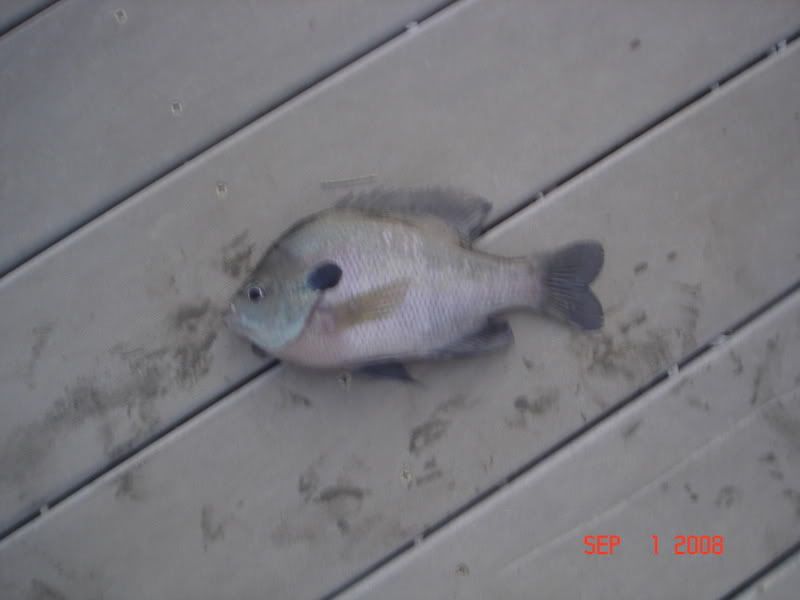
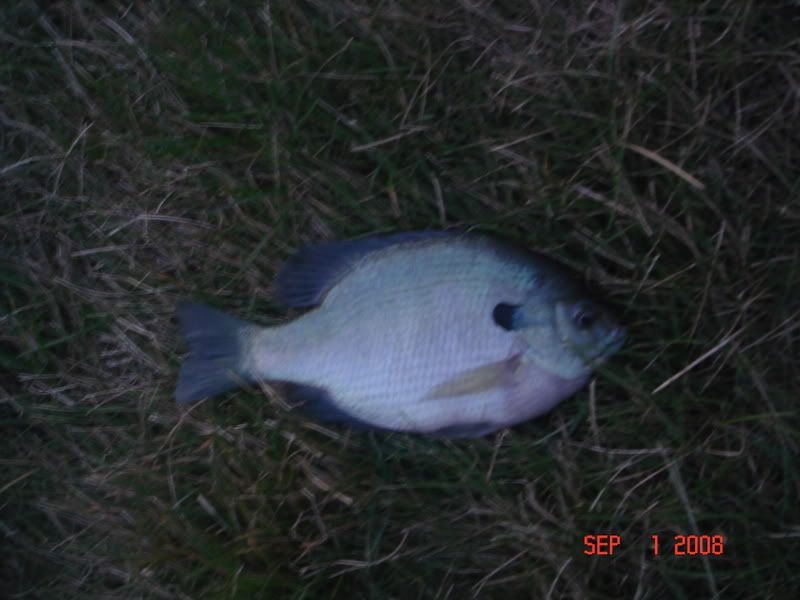
Good pictures, Ryan. Those sure look like healthy, plump fish with the more streamlined body shape. Guys? Whatcha think??
Why do my best BG look like saucers, when my pond has NO weeds?
IS it genetics?
Another mystery to figure out.

Hi guys. I'm in Ottawa at the American Fisheries Society meeting. There is a poster here on pumpkinseeds and their body morphs. That work talks about four body morphs for pumpkinseeds. One set is flowing water (streamlined) vs. standing water (compressed/saucer). The other split they had was littoral (shallow,nearshore/saucer) vs. open water (streamlined).
My WAG is genetics – these two CNBG were caught from same pond – same day – minutes apart, two weeks ago.
They are from a ¼ acre “grow-out” pond that I culled “inferior” CNBG from main pond that are a mix of native, Arkansas strain (mixed genes), and pure Florida stockers.
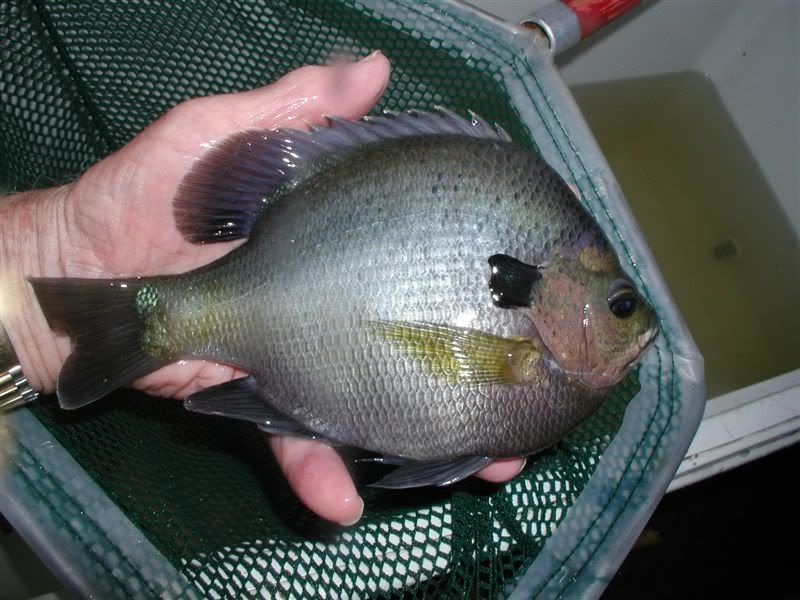
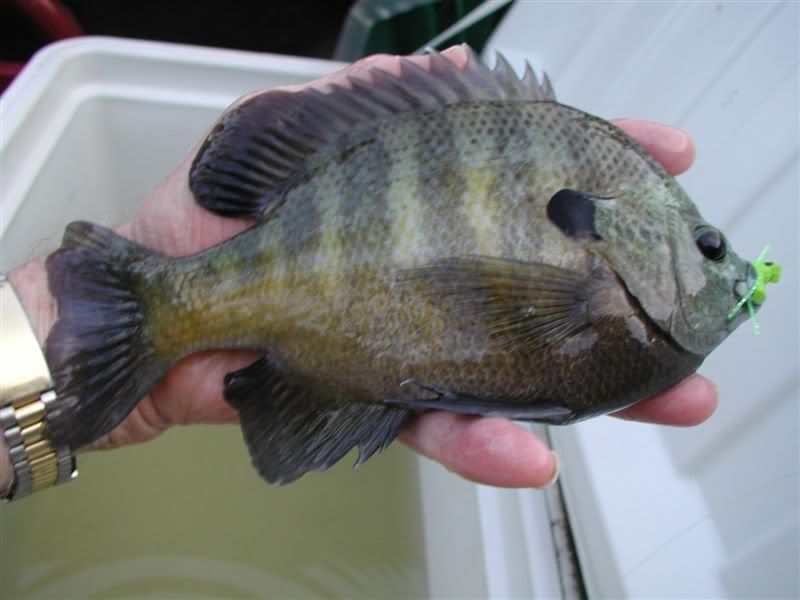
Wow! Colors and shapes all over the place. All nice fish.
George, that top fish is a freak! That's what I'm looking for. The second one is a beauty too.
Ewest, those fish look really good for such a low feeding rate. They vary so much for one body of water, even if it is 16 acres. Were your stock from multiple sources? How old is the pond?
New info on BG RWs and factors in growth and other factors like SHAPE , ENERGETIC HISTORY and GENETICS.
Interpretation of Relative Weight in Three Populations of
Wild Bluegills: A Cautionary Tale
TIMOTHY COPELAND,*1 BRIAN R. MURPHY, AND JOHN J. NEY
North American Journal of Fisheries Management 28:368–377, 2008
Copyright by the American Fisheries Society 2008
Abstract.—Physiological status of wild fish is inherently variable in time and space, and investigators need
to understand how this variation affects the interpretation of condition indices. Our objective was to describe
the relationship of relative weight (Wr) to several indicators of nutritional status (lipid, protein, and water
content, and weights of internal organs) in two populations of bluegill Lepomis macrochirus and see how well
this relationship performed when tested against an independent data set, a third
Explanatory Hypotheses
The variables we compared with Wr are commonly
used to assess the nutritional status of fish. Several
previous studies found significant correlations between
those variables and Wr. Why were correlations to Wr so
weak in this study? We developed four explanatory
hypotheses.
Differences in body shape may also be influential.
Standard weight, or Ws, the denominator used in
calculation of Wr, is exclusively a function of length.
Body shape logically affects the chances of weight
varying from changes in a dimension other than the
main body axis. A compressed species, such as
bluegill, should be more likely to exhibit changes in
shape not related to length than more cylindrical
species. Shape changes would be manifested as extra
variation about the Ws curve. Additionally, habitatrelated
differences in morphology within bluegill
populations have been demonstrated (Layzer and Clady
1987; Ehlinger and Wilson 1988). These differences
may affect the ability of a single Ws equation to remove
the size component of total weight in bluegills.
Genetics.—Bluegills may be genetically inclined
to be thin or plump and gradations between the extremes
could be found in any population. In this case, Wr
would carry limited information on nutritional status.
Energetic history.—Feeding history may influence
the relationship of Wr to body components. Shearer
(1994) cautioned that relationships predicting body
composition should be applied only to growing fish.
growth. Fed and
starved fish have different energetic strategies and both
are probably in the same population because of
resource patchiness and differences in individual
ability. Fish with ample energetic reserves grow
differently than those with depleted reserves (Broekhuizen
et al. 1994). Fasted fish will typically grow
more quickly after re-feeding than individuals that have
been fed continuously, a phenomenon termed compensatory
compensatory growth (Weatherley and Gill 1981;
Population ecology.—Energy allocation decisions
are influenced by environmental conditions, resulting
in different energy allocation strategies (Deacon and
Keast 1987; Belk and Hales 1993; Drake et al. 1997).
Allocation strategy can affect the nutritional state of
individuals as energetic investment and expenditures
are adjusted to maximize fitness (Justus and Fox 1994;
Post and Parkinson 2001). One potential effect of
alternative strategies would be to decouple Wr from
somatic investment in the individual if the majority of
energy is channeled into maturation and reproduction.
Environmental conditions may influence energy
allocation in a manner independent of reproductive
strategy (Rogers and Smith 1993). The benefits of
increased energy storage and body mass are well
known. However, increased body mass has potential
concomitant costs due to predation risk, metabolic
costs, injury risk, increased foraging, and health effects
of obesity (Witter and Cuthill 1993). Energy storage
and relative body mass are, thus, life history traits to be
optimized in terms of survival (Rogers 1987).
Habitat selection based on trade-offs between predation
risk and energetic profitability has been demonstrated
for bluegills (Werner et al. 1983; Werner and Hall
1988). These trade-offs can explain population differences
in growth and size structure (Nibbelink and
Carpenter 1998) and have implications for lipid storage
and Wr.
